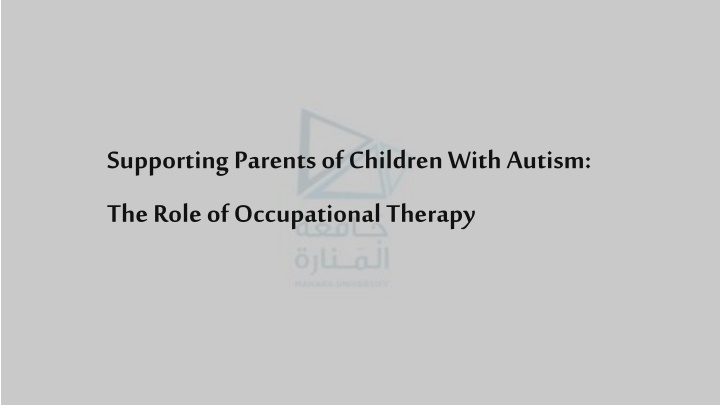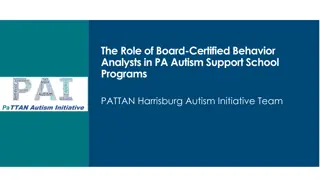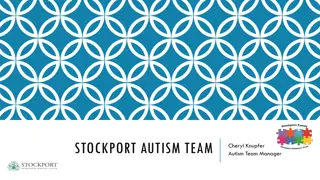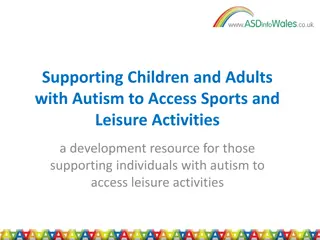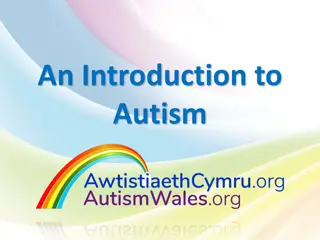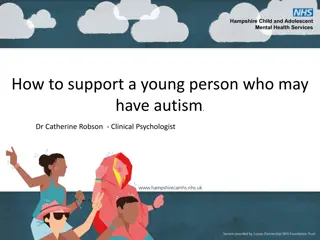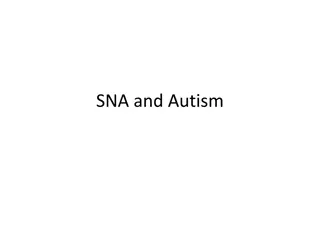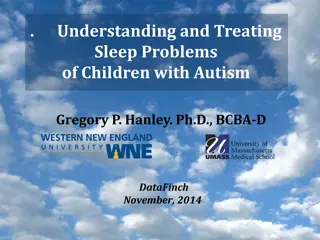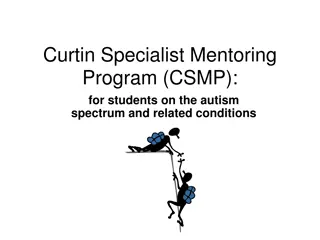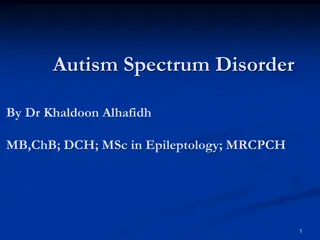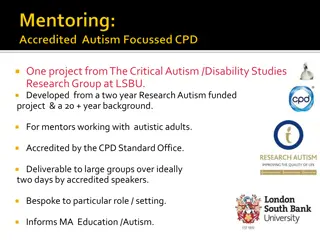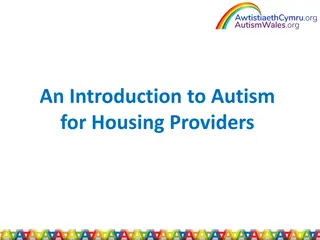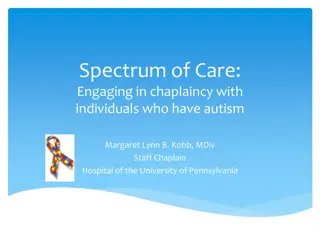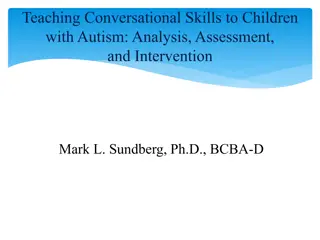Supporting Parents of Children With Autism:
Autism is a complex neurodevelopmental disorder affecting social interaction, communication, and sensory processing. Occupational therapy plays a vital role in assisting children with autism and their parents in managing behavioral challenges, sensory issues, and improving social skills. This article discusses how occupational therapy practitioners help address sensory issues, provide guidance to parents, and support positive behaviors for children with autism.
Download Presentation

Please find below an Image/Link to download the presentation.
The content on the website is provided AS IS for your information and personal use only. It may not be sold, licensed, or shared on other websites without obtaining consent from the author.If you encounter any issues during the download, it is possible that the publisher has removed the file from their server.
You are allowed to download the files provided on this website for personal or commercial use, subject to the condition that they are used lawfully. All files are the property of their respective owners.
The content on the website is provided AS IS for your information and personal use only. It may not be sold, licensed, or shared on other websites without obtaining consent from the author.
E N D
Presentation Transcript
Supporting Parents of Children With Autism: The Role of Occupational Therapy
What is Autism? Autism is a complicated neurodevelopmental disorder in which the brain does not seem to function properly. Children with autism typically have social interaction and communication impairments as well as restricted interests, activities, and play skills. Raising a child with autism is an enormous and often overwhelming task, but occupational therapy can help. Occupational therapy can help children with autism perform better in school and home environments. Parents who are referred to occupational therapy practitioners often have concerns about the behavioural and social development problems their children with autism display in these environments, and practitioners can assist with these issues.
Understanding Sensory Issues Although the behavioural and social difficulties that children with autism have are overtly displayed, many children also have sensory issues that are trickier to detect. Some of the issues in social interaction and communication, as well as some of the behaviours, are occurring because the child often has sensory processing issues, says Jane Case-Smith, EdD, OTR/L, FAOTA, professor and director of the Occupational Therapy Division of the School of Allied Medical Professions at Ohio State University. It is estimated that 80% of children with autism have sensory processing problems. This means that they can t filter out extraneous sensory stimulation or don t process sensory stimulation in the same way typically developing children do. Occupational therapy practitioners can address sensory issues and equip parents to manage their child s behaviour more successfully.
Understanding Sensory Issues Problems with sensory processing can explain why children with autism may not like noise, being touched, or the feel of certain clothing. Sometimes [parents] are very aware of these behaviours that the child is rigid, that they won t eat certain foods or don t like certain odours but nobody s really put it all together for them, says Case-Smith. What can OT practitioners do? Occupational therapy practitioners can clarify the role of sensory processing and provide advice on practical things parents can do, such as placing a weighted vest on a child if he or she needs calming. Occupational therapy practitioners also support positive behaviour, aimed to help the child s social engagement, by imitating the child s actions, waiting for his or her response, positively responding to the child, and cuing appropriate social interaction to improve social play skills.
Accessing Occupational Therapy Children with autism can access occupational therapy most easily through schools because public law mandates its availability to students with disabilities who need it. In addition, many insurance plans cover private occupational therapy for children with autism because of the severity of the disability. Children with autism usuallyreceive occupational therapy in their schools as part of their educational program.Many also receive private occupational therapy, which may be covered by insurance or paid for independently. Often sensory-based, this active type of intervention focuses specifically on helping [children] integrate their sensory systems and initiate and sustain purposeful play, says Case-Smith. Therapy can involve swings, deep touch, massage, and numerous other methods. Therapy sessions always centre on the child, incorporate play, are interactive, and provide activities that require the child to problem solve.
Creating the Intervention Plan When creating an intervention plan, occupational therapy practitioners do the following: evaluate children with autism using observation and parent and teacher reports interview parents about their child s relationships and eating, self-care, and daily living skills. In setting goals, occupational therapy practitioners work with families and teachers as a team to address the most immediate and important issues. Autism is so pervasive and it s so complex that it s critical that the entire team is focused on one or two or three priorities. [These are] typically social interaction, behaviour, and performance within a classroom, says Case-Smith. Whether practitioners modify the environment or engage in one-on-one therapy, their efforts serve the goals of the teacher and family. By collaborating with families, teachers, and other service providers, the occupational therapy practitioner strives to support academic success. An important and often overlooked part of this team is siblings. When it comes to reinforcing goals, There s quite a lot of evidence that using siblings and typical peers is pretty effective with children with autism, says Case-Smith. Siblings can take leadership roles where they initiate and direct interactions.
However, involving siblings is not an easy task adults must address the potential effect such interaction will have on the sibling. You have to help them understand that, your brother isn t going to respond to you. It doesn t mean he doesn t want to play with you; he needs you to show him how to play, says Case-Smith. For some siblings, it s overwhelming and they can t manage it, but if you have a little bit older sibling who can understand and wants to help, it can be effective. Inviting the participation of sibling also fits well into sensory integration therapy, which is playful and often involves activities done in groups or pairs. Families that include a child with autism often get to a point at which their lives revolve around that child. The whole family s schedule and activities are pretty much determined by this one child and what he needs, says Case-Smith. When talking to parents, We try and make recommendations that are helpful rather than more work, she says. Parents of children with autism have enough anxiety about whether they do enough for their child. Occupational therapy supports the parents and helps them to be more effective, reinforcing the already good work that they do.
What Is ADHD? Attention-deficit/hyperactivity disorder (ADHD) is one of the most common mental disorders affecting children. ADHD also affects many adults. Symptoms of ADHD include inattention (not being able to keep focus), hyperactivity (excess movement that is not fitting to the setting) and impulsivity (hasty acts that occur in the moment without thought). An estimated8.4% of children and 2.5% of adults have ADHD.1,2ADHD is often first identified in school-aged children when it leads to disruption in the classroom or problems with schoolwork. It is more common among boys than girls.
Symptoms and Diagnosis Many ADHD symptoms, such as high activity levels, difficulty remaining still for long periods of time and limited attention spans, are common to young children in general. The difference in children with ADHD is that their hyperactivity and inattention are noticeably greater than expected for their age and cause distress and/or problems functioning at home, at school or with friends. ADHD is diagnosed as one of three types: inattentive type, hyperactive/impulsive type or combined type. A diagnosis is based on the symptoms that have occurred over the past six months.
Inattentive type six (or five for people over 17 years) of the following symptoms occur frequently: Doesn t pay close attention to details or makes careless mistakes in school or job tasks. Has problems staying focused on tasks or activities, such as during lectures, conversations or long reading. Does not seem to listen when spoken to (i.e., seems to be elsewhere). Does not follow through on instructions and doesn t complete schoolwork, chores or job duties (may start tasks but quickly loses focus). Has problems organizing tasks and work (for instance, does not manage time well; has messy, disorganized work; misses deadlines). Avoids or dislikes tasks that require sustained mental effort, such as preparing reports and completing forms. Often loses things needed for tasks or daily life, such as school papers, books, keys, wallet, cell phone and eyeglasses. Is easily distracted. Forgets daily tasks, such as doing chores and running errands. Older teens and adults may forget to return phone calls, pay bills and keep appointments.
Hyperactive/impulsive type six (or five for people over 17 years) of the following symptoms occur frequently: Fidgets with or taps hands or feet, or squirms in seat. Not able to stay seated (in classroom, workplace). Runs about or climbs where it is inappropriate. Unable to play or do leisure activities quietly. Always on the go, as if driven by a motor. Talks too much. Blurts out an answer before a question has been finished (for instance may finish people s sentences, can t wait to speak in conversations). Has difficulty waiting his or her turn, such as while waiting in line. Interrupts or intrudes on others (for instance, cuts into conversations, games or activities, or starts using other people s things without permission). Older teens and adults may take over what others are doing.
There is no lab test to diagnose ADHD. Diagnosis involves gathering information from parents, teachers and others, filling out checklists and having a medical evaluation (including vision and hearing screening) to rule out other medical problems. The symptoms are not the result of person being defiant or hostile or unable to understand a task or instructions.
The Causes of ADHD Scientists have not yet identified the specific causes of ADHD. There is evidence that genetics contribute to ADHD. For example, three out of four children with ADHD have a relative with the disorder. Other factors that may contribute to the development of ADHD include being born prematurely, brain injury and the mother smoking, using alcohol or having extreme stress during pregnancy.
Treatment Behavioural therapy and medication can improve the symptoms of ADHD. Studies have found that a combination of behavioural therapy and medication works best for most people, particularly those with moderate to severe ADHD.
Therapy Behavioural therapy focuses on managing the symptoms of ADHD. For children, treatment usually consists of teaching parents and teachers how to provide positive feedback for desired behaviours and consequences for negative ones. Although behavioural therapy requires careful coordination, it can help children learn how to control their behaviour and make good choices. Adults with ADHD may benefit from psychotherapy and from behavioural strategies that improve structure and organization.
Medication There are two main types of medication for ADHD: stimulants and non-stimulants. Stimulant medications are highly effective treatments that have been safely used for decades. They include methylphenidate and amphetamines. As with all medicines, children taking these drugs must be carefully monitored by their parents and doctors. Two non-stimulant medications, atomoxetine and guanfacine, have also been shown to be effective in treating ADHD symptoms. These medications are alternatives for those who do not respond well to stimulants or if a non-stimulant is preferred.
Some results Some children experience dramatic relief of symptoms with medication and this relief continues with ongoing treatment. Other children may experience only partial relief or the medication may seem to stop working. A change in medication or adjustment in dose may improve the response. Other children and families may benefit from additional therapy specific to problem behaviours. The national organization Children and Adults with Attention-Deficit/Hyperactivity Disorder (CHADD) notes that many adults report that medication helps them gain more control and organization in their lives.
Parenting Children who have ADHD tend to benefit from structure, routines and clear expectations. The following may be helpful: Make clear schedules. Maintain routines. Make sure instructions are understood use simple words and demonstrate. Focus on your child when talking to him/her. Avoid multitasking. Supervise. Children with ADHD may require more supervision than their peers. Maintain communication with the child s teacher. Model calm behaviour. Focus on effort and reward good behaviour.
ADHD and the School-Aged Child Teachers and school staff can provide parents and doctors with information to help evaluate behaviour and learning problems, and can assist with behavioural training. However, school staff cannot diagnose ADHD, make decisions about treatment or require that a student take medication to attend school. Only parents and guardians can make those decisions with the child s physician. Students whose ADHD impairs their learning may qualify for special education under the Individuals with Disabilities Education Act or for a Section 504 plan (for children who do not require special education) under the Rehabilitation Act of 1973. Children with ADHD can benefit from study skills instruction, changes to the classroom setup, alternative teaching techniques and a modified curriculum.
ADHD and Adults Many adults with ADHD do not realize they have the disorder. A comprehensive evaluation typically includes a review of past and current symptoms, a medical exam and history, and use of adult rating scales or checklists. Adults with ADHD are treated with medication, psychotherapy or a combination. Behaviour management strategies, such as ways to minimize distractions and increase structure and organization, and involving immediate family members can also be helpful.
References (1) Danielson, ML, et al.Prevalence of Parent-Reported ADHD Diagnosis and Associated Treatment Among U.S. Children and Adolescents, 2016. Journal of Clinical Child & Adolescent Psychology, Volume 47, 2018 - Issue 2 (2) Simon V , Czobor P , B lint S , et al: :Prevalence and correlates of adult attention-deficit hyperactivity disorder: a meta-analysis. Br J Psychiatry194(3):204 211, 2009
